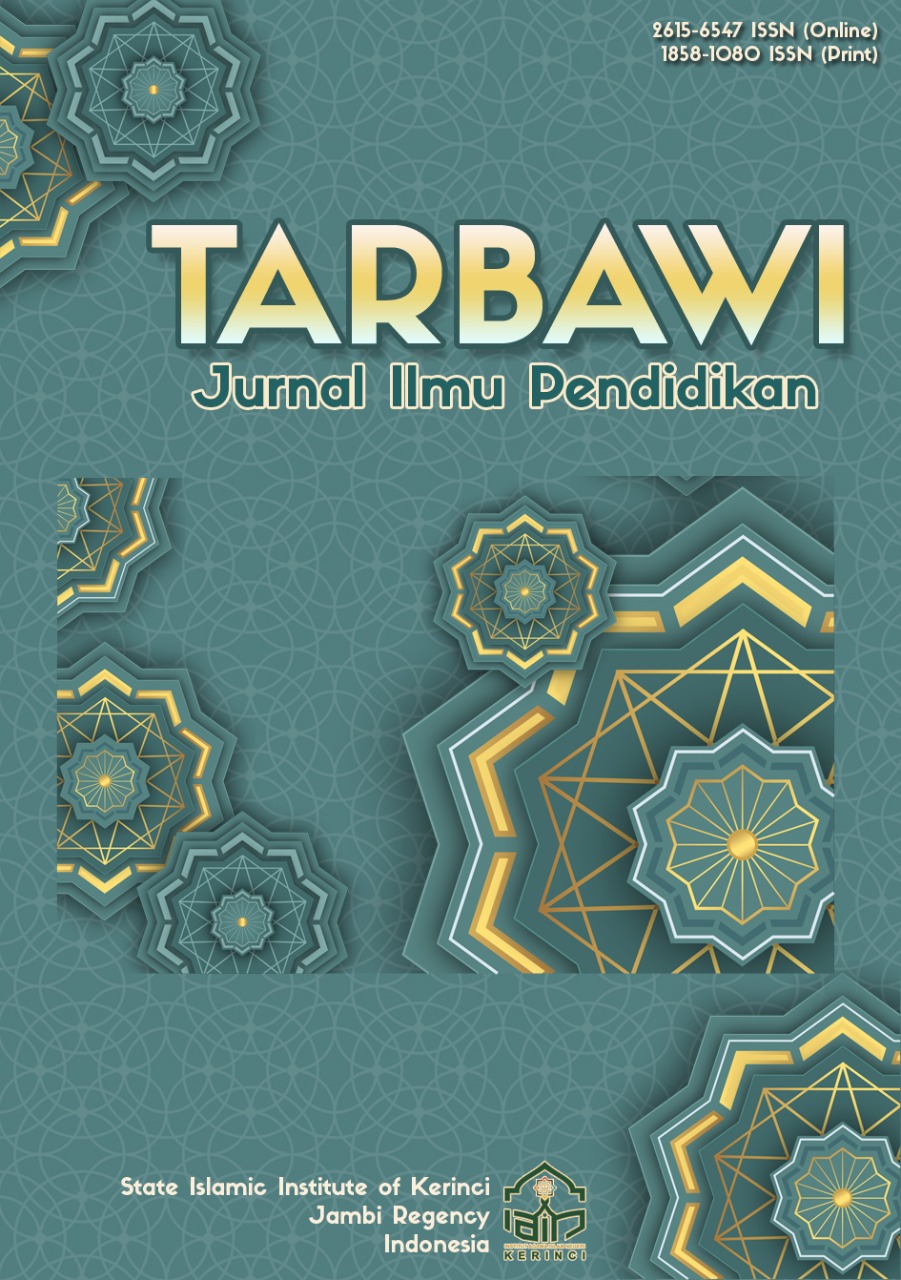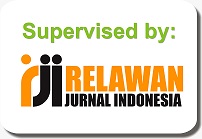The Implementation of The Time Token Arends Learning Model on Student Learning Activeness in Fiqh Subjects
DOI:
https://doi.org/10.32939/tarbawi.v20i2.4345Keywords:
Time Token Arends Learning Model, Students’ Activeness, Fiqh SubjectAbstract
This study aimed to determine the influence of student learning activeness using the Time Token Arends learning model on student learning activeness class in Fiqh subjects at a Private junior high school or boarding school. This study used an experimental method with a quantitative design. The study used sample random sampling as a technique to take the experiment class and control class. The results of this study were (1) The pre-test of the control class has a low category in learning activeness with a mean of 34.03. (2) The pre-test of the Experiment class had a low category with a mean of 38,42 in learning activeness. (3) The post-test of student learning activeness in the control class was the low category with a mean of 40,36. It was a higher mean than the pre-test mean in the control class. (4) The post-test of the experiment class in learning activeness had a low category with a mean of 45,97. Meanwhile, the post-test mean was higher than the pre-test mean. It can be concluded that Time Token Arends influenced students' learning activeness in the seventh class in Fiqh subjects at a Private junior high school or boarding school in West Pasaman Barat
Downloads
References
Ali, M., Netriwati, & Dewi, N. R. (2021). The Effect Of Laps-Heuristic Learning Model With Time Token Arends On Mathematical Problem Solving Ability. PYTHAGORAS: Jurnal Program Studi Pendidikan Matematika, 10(2), 158–164. https://doi.org/https://doi.org/10.33373/pythagoras.v10i2.3456
Amijaya, D. R., & Ristiani, I. (2023). Contextual Teaching Learning (CTL) Model in Elementary School. Jurnal Pendidikan, Bahasa Dan Budaya, 2(4), 57–63. https://doi.org/10.55606/jpbb.v2i4.2215
Anggraeni, A. W. T., Aminah, N. S., & Sukarmin, S. (2021). Experimentation of Arends’ Time Token Learning Model through Experimentation and Demonstration Methods in View of Science Process Skills of Sound and Light Waves Class XI MIPA Senior High School of 6 Surakarta. Jurnal Materi Dan Pembelajaran Fisika, 11(2), 89. https://doi.org/10.20961/jmpf.v11i2.49084
Asnita, A., & Khair, U. (2020). The Implementation of Time Token Learning Model to Improve Students’ Speaking Skills. ESTETIK : Jurnal Bahasa Indonesia, 3(1), 53. https://doi.org/10.29240/estetik.v3i1.1501
Azimah, N., & Hakim, R. (2020). Exploration of Fiqh M-learning during the Pandemic at UIN Sunan Ampel Surabaya. Atthulab: Islamic Religion Teaching and Learning Journal, 5(2), 255–269. https://doi.org/10.15575/ath.v5i2.9349
Dadi, A. F. P., & Kewa, M. (2020). The Implementation of The Time Token Learning Model Increase the Civics Education of Students’ Learning Activeness in Elementary Schools. Jurnal Basicedu, 5(1), 357–366. https://doi.org/10.31004/basicedu.v5i1.703
Damayanti, U., Bahar Amrul, & Rohiat, S. (2020). The Implementation of Time Token Learning Model to Improve the Ability to Ask Questions and Chemistry Learning Outcomes of Students of Class X Mipa1 Sman 09 Bengkulu City in the 2017/2018 Academic Year. ALOTTROP: Jurnal Pendidikan Dan Ilmu Kimia , 4(1), 1–7. https://doi.org/https://doi.org/10.33369/atp.v4i1.13693
Dulyapit, A., & Rahmah B, N. (2023). The Use of Contextual Teaching Learning (Ctl) Model to Improve Student Learning Outcomes of Class III Diversity Material At Sd Plus Al-Fathonah Madlotilah, Bekasi District. Jurnal Setia Pancasila , 4(1), 24–32. https://e-jurnal.stkippgrisumenep.ac.id/index.php/JSP
Fadillah, M. (2021). Improvement Of Social Learning Activity And Outcomes Through The Time Token Arends Model. Jurnal Socius, 10(1), 18–28. https://doi.org/10.20527
Fahrudin, & Nasir, M. (2022). Application of the Time Token Arends (TTA) Method in Improving Student Learning Outcomes in Biology Subjects in class XI MIA 2 State Senior High School of 1 Kilo Dompu Regency. JUPENJI: Jurnal Pendidikan Jompa Indonesia , 1(1), 1–9. https://jurnal.jomparnd.com/index.php/jupenji
Gay, L., Mills, G. E., & Airasian, P. (2012). Educational Research (10th ed.). Pearson.
Hanum, F., & Elfrianto. (2022). The Effect of Time Token Learning Model on Students’ Interest in Learning Mathematics. EduMatika: Jurnal MIPA, 2(3), 54–57. https://doi.org/10.30596/jcositte.v1i1.xxxx
Labudasari, E., & Hidayat Afendi, A. (2021). The Improvement of Speaking Skills Using The Time Token Arends Method on The Theme of The Area Where I Live in Class IV. Jurnal PGSD, 7(1), 25–31. https://doi.org/https://doi.org/10.32534/jps.v7i1.1937
Noviasari, E., & Rajagukguk, W. (2022). The Effect of the Time Token Type Cooperative Learning Model on Learning Activeness and Student Learning Outcomes in Class VII Number Pattern Material at Sultan Iskandar Muda Private Middle School Medan. Jurnal Ilmiah Pendidikan Holistik (JIPH), 1(3), 229–240. https://doi.org/10.55927/jiph.v1i3.2024
Nurjehan, R., & Ansari, K. (2024). Teacher Perspective: Implementation of Contextual Teaching and Learning Model. 26(1), 260–269. https://doi.org/10.21009/JTP2001.6
Nuryani, N., & Kamil, B. A. (2021). Exploring Of Online Learning Through Whatsapp: Teachers’ Perception. Jurnal Pendidikan Tambusai, 5(2), 3702–3795. https://jptam.org/index.php/jptam/article/view/1467
Paksi, G. R. (2022). Time Token Arends: A Strategy to Improve Student Engagement and Learning Outcomes in the Classroom. Edu Cendikia: Jurnal Ilmiah Kependidikan, 2(02), 345–352. https://doi.org/10.47709/educendikia.v2i02.1657
Rahayu, W., Basuki, I. A., & Anggraini, A. E. (2023). The Use of Time Token Arends Learning Model to Improve Speaking Skills of IV Class in Elementary School Students. Jurnal Ilmiah Ilmu Pendidikan, 6, 6173–6179. https://doi.org/https://doi.org/10.54371/jiip.v6i8.2103
Rahmawati, L. S., Setiawan, B., & Rahmat, R. (2023). The Implementation of Time Token Arends Cooperative Learning Model on Pawarta Text in Class X Students Of Sman 1 Karanggede. Sabdasastra : Jurnal Pendidikan Bahasa Jawa, 7(2), 267. https://doi.org/10.20961/sabpbj.v7i2.77216
Retno, O. :, & Purwati, P. (2020). The Efforts Increasing The Students’ Learning Activeness with a Discovery Learning Approach Using Google Classroom. Jurnal Pendidikan Sosiologi Dan Antropologi, 4(1), 202–212. https://doi.org/10.20961/habitus.v4i1.45725
Rikawati, K., & Sitinjak, D. (2020). The Increasing Student Learning Activeness with the Use of Interactive Lecture Method. Journal of Educational Chemistry (JEC), 2(2), 40. https://doi.org/10.21580/jec.2020.2.2.6059
Refanda, F. R., & Dzarna. (2023). Application of Student Centered Learning Method for 2nd Grade Students of SD Muhammadiyah Kaliwates Jember. Journal of Education Research, 4(4), 2050–2057. https://doi.org/https://doi.org/10.37985/jer.v4i4.427
Saprisal. (2023). The Effect of Understanding Fiqh Subjects on the Activeness of Students’ praying in Class XII IPA State Islamic Senior High School of 3 Pesisir Selatan. ALACRITY: Journal of Education , 3(3), 22–31. https://doi.org/10.52121/alacrity.v3i3.179
Sembiring, A. B., Tanjung, D. S., & Silaban, P. J. (2021). The Effect of Time Token Learning Model on Elementary School Students’ Learning Motivation in Thematic Learning. Jurnal Basicedu, 5(5), 4076–4084. https://doi.org/10.31004/basicedu.v5i5.1289
Silalahi, D. E., R Sihombing, P. S., & Purba, L. (2021). The High Order Thinking Skill (Hots) Questions on Learners’ Writing Ability of Report Text at EFL of FKIP Universitas HKBP Nommensen. 14(2). https://doi.org/10.33541/jdp.v14i1.1295
Anggraini, K. C. S., & Aulia, I. (2023). Implementation of Contextual Teaching and Learning Model on Student Learning Outcomes. BASICA Journal of Arts and Science in Primary Education, 3(2), 13–24. https://doi.org/10.37680/basica.v3i2.4138
Sinta, T., Anisa, I., & Ratna Widayanti, S. (2019). International Journal of Active Learning English Academic Writing for The Students of Widya Dharma University of Klaten. http://journal.unnes.ac.id/nju/index.php/ijal
Son, R. S. S. (2019). Pengaruh Model Pembelajaran Kooperatif Tipe Time Token Terhadap Hasil Belajar Siswa SMP The Influence Of Cooperative Learning “Time Token” Towards Students’ Learning Result In Junior High School. Jurnal Pendidikan Dan Kebudayaan, 9(3), 284–291. https://doi.org/10.24246/j.js.2019.v9.i3.p284-291
Syahza, A. (2021). Research Methodology. UR Press. https://www.researchgate.net/publication/354697863
Syarifah, N. R., & Misbah, M. (2023). Contextual Teaching and Learning Model on Jurisprudence Learning at Islamic Primary School of Ya Bakii Kalisabuk 03. Jurnal Kependidikan, 11(2), 289–300. https://doi.org/10.24090/jk.v11i2.9288
Ta’dungan, F. (2021). Increasing Student’s Learning Interest and Student Learning Activeness in Class VII. Science, Engineering, Education, and Development Studies (SEEDS), 5(2), 52–56. https://doi.org/https://doi.org/10.20961/seeds.v5i2.56850
Wijayanti, S., & Suyanto, I. (2019). The Implementation of Time Token Arends Type Cooperative Learning Model with Pop Up Media to Improve Speaking Skills in Class III Students of State Primary School of 3 Kalirejo. Jurnal Ilmiah Kependidikan, 7(1), 61–66. https://doi.org/https://doi.org/10.20961/jkc.v7i1.40689
Yasin, M. N., Syuhud, & Muttaqin, A. I. (2024). Improving Student Learning Activeness in Fiqh Subjects Through Contextual Learning. JRIP: Jurnal Riset Dan Inovasi Belajar , 4(1), 698–713. https://doi.org/https://doi.org/10.51574/jrip.v4i1.1353
Downloads
Published
Issue
Section
License
Copyright (c) 2024 Radhiatul Hasnah, Iilpi Zukdi, Adriantoni Adriantoni, Sry Utami

This work is licensed under a Creative Commons Attribution-ShareAlike 4.0 International License.









